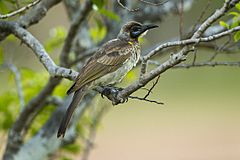Little friarbird facts for kids
Quick facts for kids Little friarbird |
|
|---|---|
 |
|
| Conservation status | |
| Scientific classification |
The little friarbird (Philemon citreogularis) is a cool bird. It's also called the little leatherhead or yellow-throated friarbird. This bird is the smallest of all the friarbirds. You can find it in northern and eastern Australia. It also lives in southern Papua New Guinea.
Little friarbirds are easy to spot. They often chase other honeyeaters. They are also very noisy! But you will usually see them high up in trees. They rarely come down to the ground.
Contents
What Does It Look Like?
The little friarbird is about 25 to 30 centimeters (10 to 12 inches) long. Most are around 27 centimeters (11 inches). They weigh about 67 grams (2.4 ounces). Male and female friarbirds look very similar. However, males are usually a bit bigger.
You can easily tell this friarbird apart from others. It does not have a casque. A casque is a big bump on the beak that some other friarbirds have. Another easy way to spot it is the bare blue skin under its eye. This blue skin gets wider over its cheek. The skin color can change from gray to black. Dark feathers are above and below this blue skin.
The top of its head and body are a dark gray-brown. It has a dull white fringe on the back of its neck. This fringe goes around to a wide patch on the side of its neck. Under its chin, it has fine, silky white feathers. Silvery white streaks go down its chest. These streaks turn into pale gray on its belly.
The little friarbird also has a black, curved beak. Its eyes are dark brown. Its legs are bluish-black. When it flies, its wings beat in a shallow, shaky way. Its tail looks square when spread out. It has slight pale tips on its tail feathers.
Young Friarbirds
Young little friarbirds look paler than adults. Their facial skin is lighter. Their chin, throat, and sometimes their upper chest look yellowish. They might even have yellow spots on the side of their chest. The name 'citreogularis' often describes young birds with a yellow front neck. Their tail feathers also have a shallower cut than adult birds.
What Does It Sound Like?
The little friarbird has a very special voice. It often makes a repeated, soft "gee-wit" or "chewip" sound. When they are breeding, their song gets longer. It includes chattering and scolding sounds. One common call sounds like "rackety-crookshank."
What Do They Eat?
Little friarbirds eat alone, in pairs, or in small groups. They usually stay in trees to find food. They often feed with other honeyeaters in mixed groups. They eat nectar from flowers. They also enjoy blossoms, fruit, and small bugs. Sometimes, they eat flowers and seeds too.
Where Do They Live?
The little friarbird is mostly found in northern Australia. They move to south-east Australia during certain seasons. You can see them from Broome in Western Australia. They are also in the Kimberleys and northern Northern Territory. They have been seen across most of Queensland. They go as far inland as Mount Isa.
In summer, they spread across south-east Australia. This includes New South Wales, Victoria, and South Australia. They are also in the Australian Capital Territory. You can find them along the Murray River. They are also in the Riverina area of New South Wales. In Victoria, they live in the north-central part. They are also near big water bodies like Hattah Lakes. You can see them as far as Morgan on the Murray River in South Australia. They also live in southern Papua New Guinea. They are on some islands near Australia too.
Little friarbirds mostly live near water. You can find them in swampy woodlands and mangroves. They also live in open forests and woodlands. These areas often have many Eucalyptus trees. During good flowering seasons, they might visit orchards, vineyards, and gardens. They can even live in dry areas if there is enough water nearby.
Reproduction
Little friarbirds form pairs to have babies. They stay together for breeding. Breeding times can be different. The earliest records are in July, and the latest are in February. Both parents help build the nest. The nest is like a deep, open cup. It is often thin, so you can see through it. You might even see the eggs!
The nest is made from many things. These include bark fibers, fine grass, and spider webs. They also use rootlets and hair. Nests are usually built over water. They are low in tree branches, about 2 to 10 meters (6 to 33 feet) high. They hang from twigs or hidden in leaves.
A female usually lays 2 or 3 eggs. Sometimes she lays 4. The eggs are oval-shaped. They are about 20 by 27 millimeters (0.8 by 1.1 inches) in size. The eggs are chestnut in color. They can be whitish-pink to salmon-red. They might also have purplish-red or purple spots.
A pair can raise up to 2 groups of babies in one breeding season. Only the female sits on the eggs to keep them warm. This is called incubation. One nesting period takes about 14 days. The eggs hatch after about 13 days of incubation.
During breeding season, another bird sometimes lays its eggs in the friarbird's nest. This is called brood parasitism. The common koel (Eudynamys scolopacea), a type of cuckoo, often does this. The friarbird then raises the cuckoo's chick as its own.
Gallery
See also
 In Spanish: Filemón goligualdo para niños
In Spanish: Filemón goligualdo para niños



